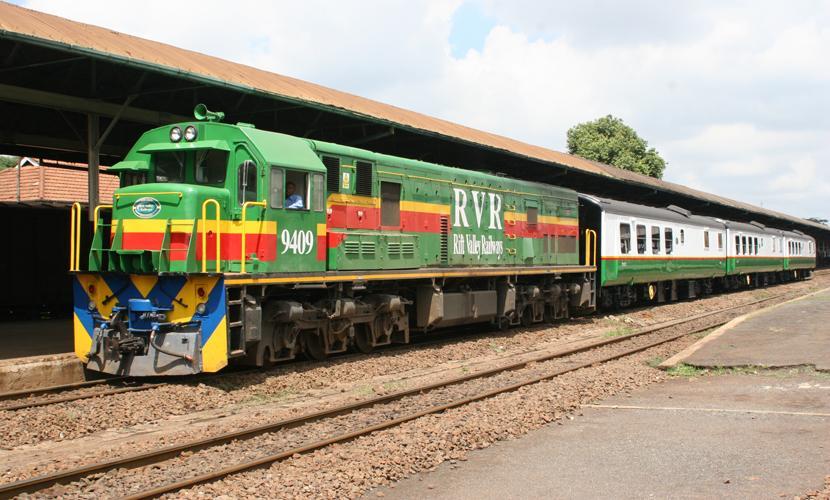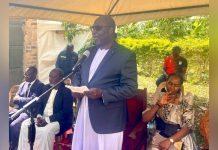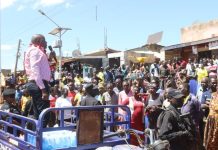Faridah n Kulumba
Africa-Press – Uganda. The government of the Republic of Kenya revealed plans to resume discussions with the government of China over funding an extension of a railway line to the Uganda border, eight years after negotiations began.
Chinese funding helped Kenya construct a 730-kilometer (453-mile) railroad from Mombasa port on the Indian Ocean to Naivasha, northwest of Nairobi.
According to the cabinet secretary at Kenya’s Ministry of Roads and Transport, Kenya’s authorities are updating the feasibility study of extending the line to the Ugandan border, Kipchumba Murkomen, told reporters in Kampala, Uganda’s capital by July 1.
Setbacks
The Standard Gauge Railway (SGR) was introduced in 2014 by regional leaders from Kenya, Uganda, Rwanda and South Sudan. Unfortunately when the railway line reached Naivasha, the Kenyan authorities put an end to it. The Chinese funders also declined to fund the SGR project on the Ugandan side.
The government of Kenya had declined to get more funding from the Chinese financial institution over budget and political issues.
The government of Kenya said that loans from China have remained high and Kenya is not willing to service any new loans from Beijing.
Earlier this month Kenya said that they have been having talks with China, but it seems funds are not coming at the terms they were proposing. The country vowed to continue with the plan to build SGR to connect Naivasha and Kampala seeking for an alternative financier.
On 18th May 2023, Uganda’s Ministry of Works and Transport said that Kenya and Uganda were planning to seek an alternative financier for the SGR project to connect both countries. But did not name which specific European funders Uganda was wooing.
On 12th January this year Uganda agreed to give the same Turkish private company Yapi Merkezi a contract for the construction of Tanzania Standard Gauge Railway for construction of the SGR on the eastern and western of Malaba-Kampala-Kigali after the termination of the contract of China Harbour Engineering Company (CHEC) that had previously been contracted to build the 273-kilometer line from Malaba to Kampala after the firm failed to convince China Exim Bank to finance the project.
Uganda had in 2015 entered into an agreement with Chinese firm China Harbour and Engineering Company Ltd to implement the project on the condition the firm helps secure funds for the railway from the China government.
After years of fruitless talks with China on the funds, however, Uganda early this year terminated the agreement and instead commenced negotiations with Yapi Merkezi to undertake the project.
Uganda is banking on the railway to boost speed and lower the cost of transporting exports such as coffee and tobacco. It currently relies on costly and slow road links and a century-old narrow gauge rail line built by former colonial power Britain.
Northern Corridor Transit and Transport Coordination Authority (NCTTCA) Executive Secretary Justus Omae confirmed that East African states will be meeting in June this year to discuss intermodal transport and SGR funding is on the agenda.
Conditions
In 2019, then Kenyan President Uhuru Kenyatta while in China failed to secure USD 3.68 billion to fund the third phase of his signature SGR project, a critical segment of the Northern Corridor project that is supposed to link the port of Mombasa with the Great Lakes Region’s landlocked states.
Instead, Kenya bagged some USD 400 million to be used to upgrade its 120-year-old meter gauge railway to Malaba on the border with Uganda.
President Kenyatta had hoped to secure the fund to take the SGR line from Naivasha in Central Rift Valley to Kisumu, and on to the Malaba border from where Uganda would take over construction to Kampala and beyond.
China withheld funding for the final segment of the SGR to the Uganda border. Beijing’s assessment indicated that without Uganda, whose participation is key to connecting South Sudan and Rwanda to Mombasa, the SGR’s viability is grossly undermined.
Uganda is jubilating
When the government of Kenya decided to accept the extension of the SGR from the Naivasha to Malaba border, Uganda welcomed Kenya’s decision saying the development will connect Kampala and Mombasa cities.
Uganda was happy that Kenya had gone back to the original plan of extending the SGR to Uganda’s border Malaba and then Uganda would also construct it for other neighboring countries.
If the June meeting fails to reach an agreement for joint SGR project funding, Nairobi will have to wait longer before the construction of the modern railway. The Kenyan government failed to allocate funds in the next three years to the transport ministry to extend the SGR beyond Naivasha to Kisumu and finally Malaba.
For More News And Analysis About Uganda Follow Africa-Press






